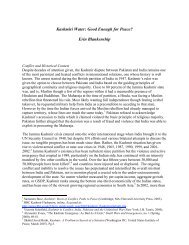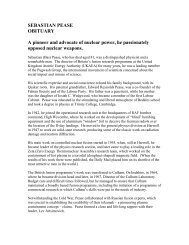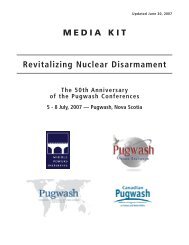Eliminating Stockpiles of Highly Enriched Uranium - Pugwash ...
Eliminating Stockpiles of Highly Enriched Uranium - Pugwash ...
Eliminating Stockpiles of Highly Enriched Uranium - Pugwash ...
You also want an ePaper? Increase the reach of your titles
YUMPU automatically turns print PDFs into web optimized ePapers that Google loves.
Effects <strong>of</strong> crude nuclear explosive devices with HEU<br />
A crude nuclear explosive device manufactured using HEU could yield an explosion<br />
effect equivalent to that <strong>of</strong> several hundreds to a few thousand tons <strong>of</strong> TNT. Any predetonation<br />
would cause the device to disintegrate prematurely with a lower yield. 25<br />
Thus, while the exact yield would be unpredictable, it is almost certain that it would<br />
exceed the explosion size and impact <strong>of</strong> all previous terrorist attacks. It might, with a<br />
significant probability, be analogous to that <strong>of</strong> the Hiroshima bomb. A 13-kiloton<br />
explosive yield <strong>of</strong> TNT equivalent then resulted from the fissioning <strong>of</strong> 700 grams <strong>of</strong><br />
HEU. 26<br />
Crude nuclear devices by terrorists are likely to be detonated on the ground<br />
(not in the air). The explosion would thus create a huge crater and the resulting dust<br />
and debris would be sucked up in air and into the characteristic mushroom cloud.<br />
Hence, while the effects <strong>of</strong> the shockwave may be less severe due to possible<br />
shielding (houses and building structures), the radioactive fallout and population<br />
doses are likely to be much more severe than for a nuclear atmospheric explosion.<br />
This will, moreover, complicate rescue efforts. Persons who survive the initial nuclear<br />
blast may face long-term suffering. A terrorist Hiroshima-yield explosion downtown<br />
in a large and densely populated city could thus result in hundred thousands <strong>of</strong><br />
casualties and property damage that, to the extent they could be estimated, could<br />
amount to trillions <strong>of</strong> dollars. 27<br />
25 The supercritical state <strong>of</strong> the HEU must thus be maintained long enough for the neutron<br />
multiplication to proceed for a sufficiently large number <strong>of</strong> generations. A yield <strong>of</strong> 10 kilotons requires<br />
about 10 24 neutron-induced fission events. This is equal to roughly 80 generations and could elapse<br />
within microseconds. From Albert Narath, “The Technical Opportunities for a Sub-National Group to<br />
Acquire Nuclear Weapons”, XIV Amaldi Conference on Global Security”, April 27, 2002.<br />
26 The energy yield due to complete fissioning <strong>of</strong> one kilogram <strong>of</strong> HEU is equivalent to that <strong>of</strong><br />
approximately 17 kilotons <strong>of</strong> chemical explosives. The Hiroshima bomb contained some 65 kilograms<br />
<strong>of</strong> uranium enriched to 84%. The fission efficiency <strong>of</strong> the device was thus approximately 1%.<br />
Terrorists, however, would probably consider a conversion <strong>of</strong> even less than 1% quite acceptable. For<br />
more on this, see e.g. Albert Narath, “The Technical Opportunities for a Sub-National Group to<br />
Acquire Nuclear Weapons”, XIV Amaldi Conference on Global Security”, April 27, 2002 .<br />
27 A nuclear terrorist explosion stemming from a crude nuclear explosive device is not directly<br />
comparable to the Hiroshima-blast. Firstly, the uranium bomb dropped on Hiroshima was exploded<br />
above ground. Secondly, the housing in the city was highly combustible, thirdly, surroundings and<br />
possible shielding may influence the bomb yield. In Hiroshima, almost everything up to about one<br />
mile (1.6 kilometres) from below the point where the bomb exploded (ground zero) was destroyed.<br />
Two-thirds <strong>of</strong> the city’s structure was ruined or severely damaged by the atomic bomb. Flash ignition<br />
<strong>of</strong> dry, combustible material was observed as far as approx. 6400 feet (approx. 2000 meters) from<br />
ground zero. Fires sprang up simultaneously all over the wide flat central area <strong>of</strong> the city, resulting in<br />
an immense firestorm. This firestorm burned out almost everything in a roughly circular area <strong>of</strong> 4.4<br />
square miles (approx. 11 square kilometers) around the point directly under the explosion. Of the total<br />
Hiroshima population <strong>of</strong> 255,000 people, early - but contested for being too conservative - U.S.<br />
estimates suggest 66,000 immediate dead and 69,000 injured. See the Official U.S. Report on the<br />
Atomic Bomb’s Effects in Hiroshima and Nagasaki: The Manhattan Engineer District, “The Atomic<br />
Bombings <strong>of</strong> Hiroshima and Nagasaki”, June 29, 1946. The report is made available at The Avalon<br />
Project at Yale Law School, http://www.yale.edu/lawweb/avalon/abomb/mpmenu.htm . Other<br />
estimates indicate higher numbers.<br />
16







